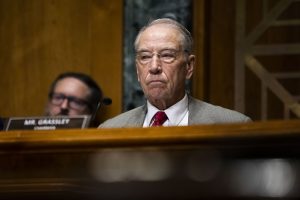 Members of the International Brotherhood of Teamsters protest in 2016 a plan by the Central States Pension Fund to reduce payments to retirees. Central States is a massive multiemployer plan that is projected to be insolvent by 2025. (Photo: Drew Angerer/Bloomberg)
Members of the International Brotherhood of Teamsters protest in 2016 a plan by the Central States Pension Fund to reduce payments to retirees. Central States is a massive multiemployer plan that is projected to be insolvent by 2025. (Photo: Drew Angerer/Bloomberg)
Republican lawmakers in the Senate are advancing a proposal to rescue collectively bargained multiemployer plans headed toward insolvency.
Related: Union pensions: Will Congress kick the can on a solution?
The Multiemployer Pension Recapitalization and Reform Plan, authored by Sen. Chuck Grassley, R-IA, chair of the Senate Finance Committee, and Sen. Lamar Alexander, R-TN, chair of the Health, Education, Labor, and Pensions Committee, takes dramatically different steps to Democratic-backed legislation that advanced out of the House of Representatives this summer.
Partitioning orphaned participants
The proposal would partition orphaned participants from the 125 multiemployer plans in critical and declining status, allowing the original plan to continue paying benefits with contributions from healthy employers.
 Senator Charles Grassley (R-IA) during a Senate Committee on Finance hearing in 2019. (Photo: Diego M. Radzinschi/ALM)
Senator Charles Grassley (R-IA) during a Senate Committee on Finance hearing in 2019. (Photo: Diego M. Radzinschi/ALM)Orphaned participants of employers that leave plans degrade funded statuses, according to a white paper explaining the reform proposal.
"Partitioning is akin to creation of a 'healthy pension' that continues in a healthy fashion and a separate 'sick pension' that requires attention and assistance from the PBGC," the proposal says.
Raising PBGC premiums
The Pension Benefit Guaranty Corp.'s multiemployer insurance program is running a $65.2 billion deficit, and is projected to be insolvent in 2025 after two large plans run out of cash.
 Senator Lamar Alexander (R-TN) during a Senate Health, Education, Labor, and Pensions Committee, 2019. (Photo: Diego M. Radzinschi/ALM)
Senator Lamar Alexander (R-TN) during a Senate Health, Education, Labor, and Pensions Committee, 2019. (Photo: Diego M. Radzinschi/ALM)The proposal from Grassley and Alexander would dramatically raise premiums multiemployer plans pay to PBGC. Under existing law, all multiemployer plans pay a flat per-head premium of $29.
That would be raised to $80 under the proposal, on par with PBGC's single-employer flat rate. The proposal would also introduce a variable rate for multiemployer plans that are not fully funded, as is done with single-employer plans.
And it would broaden the contribution base by requiring a monthly $2.50 co-payment on active workers and most retirees.
The extra premium revenue and new co-payments would allow PBGC to raise its maximum benefit backstop, which is now just under $13,000 annually.
Stricter discount rates
Under current law, multiemployer plans have wide latitude in applying the discount rates that determine future plan liabilities, and in turn determine promised benefits and necessary employer contributions.
Single-employer plans, however, have strict limitations on the discount rates applied to plan liabilities, resulting in more conservative estimates of returns on invested assets.
The average discount rate assumed by multiemployer plans is 7.13 percent, according to the PBGC.
Under the proposal, the maximum discount rate would be 6 percent, and the cap would be phased in over five years to allow plans time to smooth the subsequent increases in contributions.
The proposal also reforms rules governing the withdrawal liability individual employers pay when they leave plans. Those liabilities would be reduced as plan funded levels improve.
"This crisis is severe and gets worse every day. Around 125 multiemployer plans have said they'll become insolvent over the next two decades. Several large plans—including the big Central States Pension Fund—predict they'll go insolvent in the next few years. This leaves more than 1.3 million participants without the pension benefits they've been promised, including 10,000 Iowans," Sen. Grassley said in a statement.
"We need to act quickly, but we can't just pour money into failing and mismanaged funds. Our plan will provide relief and reform now, without it our retirees will be left without the future they worked for," he added.
READ MORE:
© 2025 ALM Global, LLC, All Rights Reserved. Request academic re-use from www.copyright.com. All other uses, submit a request to [email protected]. For more information visit Asset & Logo Licensing.








